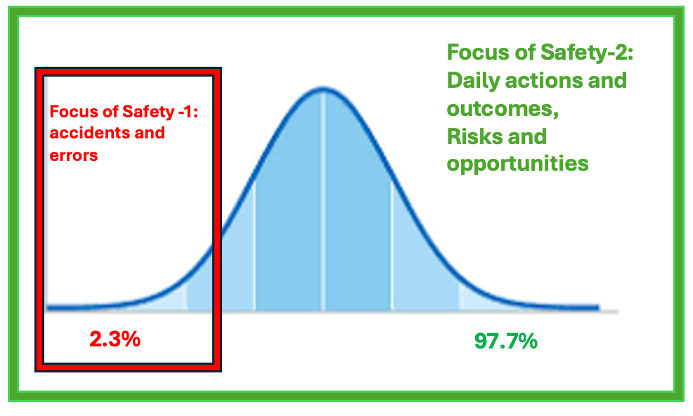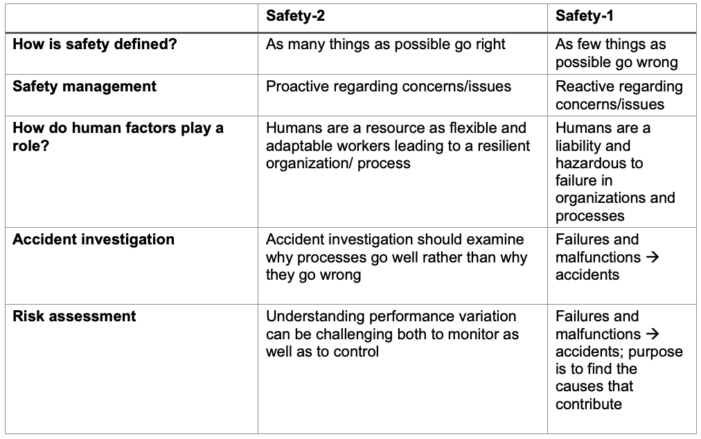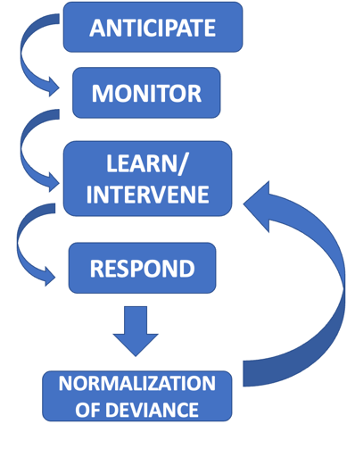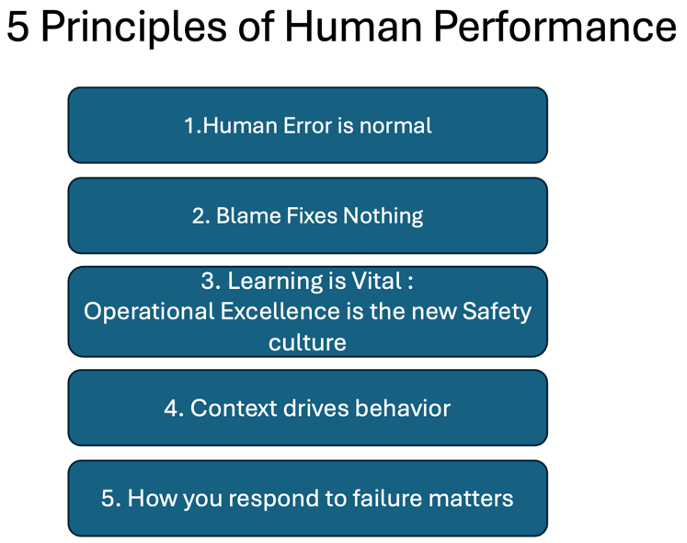Copy link
Safety II
Last updated: 10/07/2024
Key Points
- The evolution of safety has progressed in a stepwise fashion, much like building blocks, with each subsequent safety framework becoming more adaptive and encompassing as healthcare and our patients become more complex.
- Safety-2 is a framework focused on what goes right rather than what goes wrong.
- Safety-2 concepts include human performance, adaptability, “drift into failure,” “work-as-imagined versus work-as-done,” “efficiency thoroughness trade-off,” and resilience engineering.
Introduction
- Over the last 70 years, the field of safety has progressed through various frameworks.
- Each subsequent safety framework has built upon the previous framework to better display an understanding of processes and event analysis.
- The goals of each framework are different, initiating a different process for analyzing safety events.
- Additionally, regulatory requirements often drive the safety process in place.
- In the 1950s, the number of anesthesia mortalities increased, and safety frameworks were developed to mitigate the potential for safety problems.
- Continued increases in medical malpractice and safety events have encouraged organizations to improve how they analyze these events.1,2 For example, a sentinel event would initiate a root cause analysis (RCA) in many organizations based on its response to Joint Commission Organization standards.
Safety Frameworks
- Safety-0 is the oldest framework that relies on individual failure, staffing, education, and other basic standards to describe the cause of an event.
- Safety-1 is the framework that most healthcare organizations use. It is focused on systems-related problems, safety analytics, and organizational culture.3-5
- Safety-2 is a newer concept described by many teams in aviation and other nuclear power industries. It highlights the importance of human performance and the worker’s ability to adapt to an ever-changing world to mitigate errors and improve system performance.3-5
Comparing Safety-1 and Safety-2
- The focus of Safety-1 is on the small percentage of errors. The focus of Safety-2 is on the small percentage of errors and the overwhelmingly large percentage of good outcomes while trying to better understand the good outcomes (Figure 1).
- The concepts in Safety-2 focus on the power and importance of human performance and a team member’s ability to be adaptable. It also emphasizes learning from others “how to do it well.”
- Safety-2 is not focused on placing blame on individual failure, poor staffing, or lack of education, which is often part of Safety-1.
- For example, if the same procedure is done 100 times, why does it go well 98/100 times? What were the consistent elements of the 98 procedures? (Figure 1, Table 1)

Figure 1. Where does Safety-1 versus Safety-2 focus?
Adapted from Hollnagel E, Wears RL, Braithwaite J. Middelfart, From Safety-I to Safety-II: A White Paper. Denmark: Resilient Health Care Net; 2015
- Safety-2 emphasizes the workers as the “asset” rather than the “liability.”
- Understanding the true workflow and processes for the team is of utmost importance to the Safety-2 framework.
- Safety-2 seeks to understand how day-to-day work is completed, not how it is imagined to be completed.
- For example, if a barcode scanner is supposed to scan medications before “safe” administration, but it rarely works, the natural tendency will be to stop utilizing the technology that is lacking.

Table 1. Comparison of Safety-1 and Safety-2 frameworks. Courtesy of Megha Kanjia
Concepts of Safety-2
- The underlying theme of Safety-2 concepts is that understanding both a system and its workers is paramount in recognizing its failures and successes.
- Sidney Dekker’s concept of “drift into failure” examines stepwise deviations from a normal practice that eventually lead to the failure of a system.6
- “Work-as-imagined versus work-as-done” highlights the reality of how everyday work is completed.
- “Efficiency thoroughness trade-off” focuses on the push and pull of efficiency and thoroughness and how each of these changes in varying system.7
- Resilience engineering highlights that teams and systems have to function in a way that they can anticipate – monitor – respond – and learn from ongoing problems and processes while utilizing these opportunities to make adaptations to apply to organizational processes. (Figure 2)
- Todd Conklin has identified the 5 Principles of Human Performance (Figure 3), which are instrumental in better understanding the “why” of workers’ performance and the principles that guide performance within organizations.

Figure 2. Resilience Engineering Model showing the natural feedback of Anticipate – Monitor – Learn – Respond, Courtesy of Megha Kanjia

Figure 3. Todd Conklin’s 5 Principles of Human Performance.
Adapted from Conklin, T. (2019). The 5 Principles of Human Performance: A contemporary update of the building blocks of Human Performance for the new view of safety. Pre-Accident Investigation Media.
- While these concepts are theoretical, they do highlight the importance of gaining a true understanding of processes to analyze the potential for failure.
- Additionally, comparing processes to those of other departments, individuals, or organizations who are doing something “well” helps to improve their own systems as they evolve and adapt.
- Discussing normal safety standards and understanding how the team members would function in the system is important to understand how processes move forward within systems.
References
- Warner MA, Warner ME. The evolution of the anesthesia patient safety movement in America: Lessons learned and considerations to promote further improvement in patient safety. Anesthesiology 2021; 135:963-75. PubMed
- Beecher HK, Todd DP. A Study of deaths associated with anesthesia and surgery: Based on a study of 559,548 anesthesia in ten institutions 1948-1952. Ann Surg 1954; 140:2-35. PubMed
- Bates DW, Williams EA. Quality and safety: Learning from the past and re-imagining the future. J All Clin Immunol Pract 2022; 3141-4. PubMed
- Dekker S. The field guide to understanding human error. Ashgate Publishing Company, Burlington, VT, 2006.
- Hollnagel E, Wears RL, Braithwaite J. Middelfart. From Safety-I to Safety-II: A white paper. Denmark: Resilient Health Care Net; 2015. Link
- Dekker S. Drift into failure: From hunting broken components to understanding complex systems (1st Edition). CRC Press, Boca Raton, FL, 2011.
- Hollnagel E. The ETTO principle: Efficiency-Thoroughness Trade-Off: Why things that go right sometimes go wrong (1st Edition). CRC Press, Boca Raton, FL, 2009.
Other References
Copyright Information

This work is licensed under a Creative Commons Attribution-NonCommercial-NoDerivatives 4.0 International License.